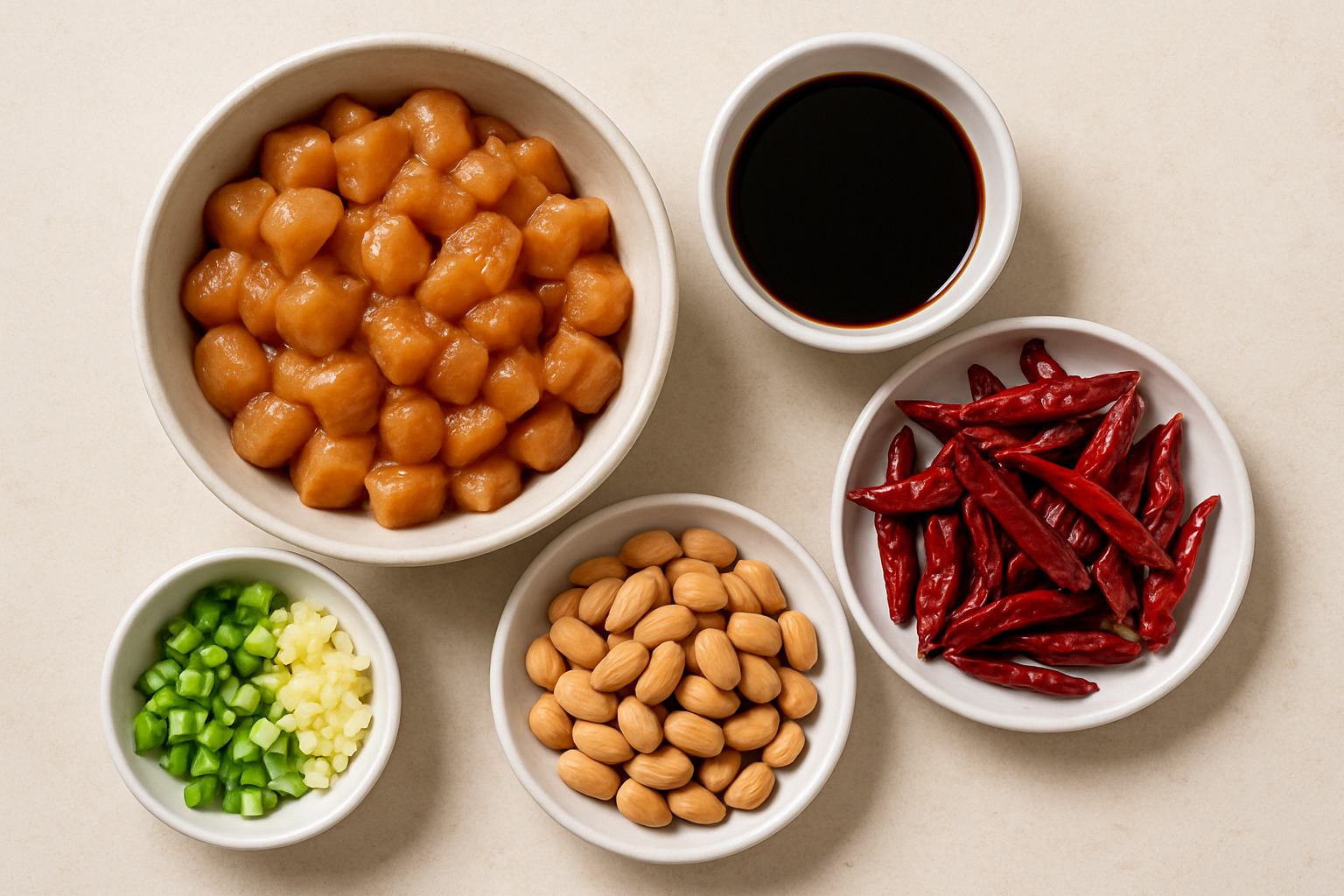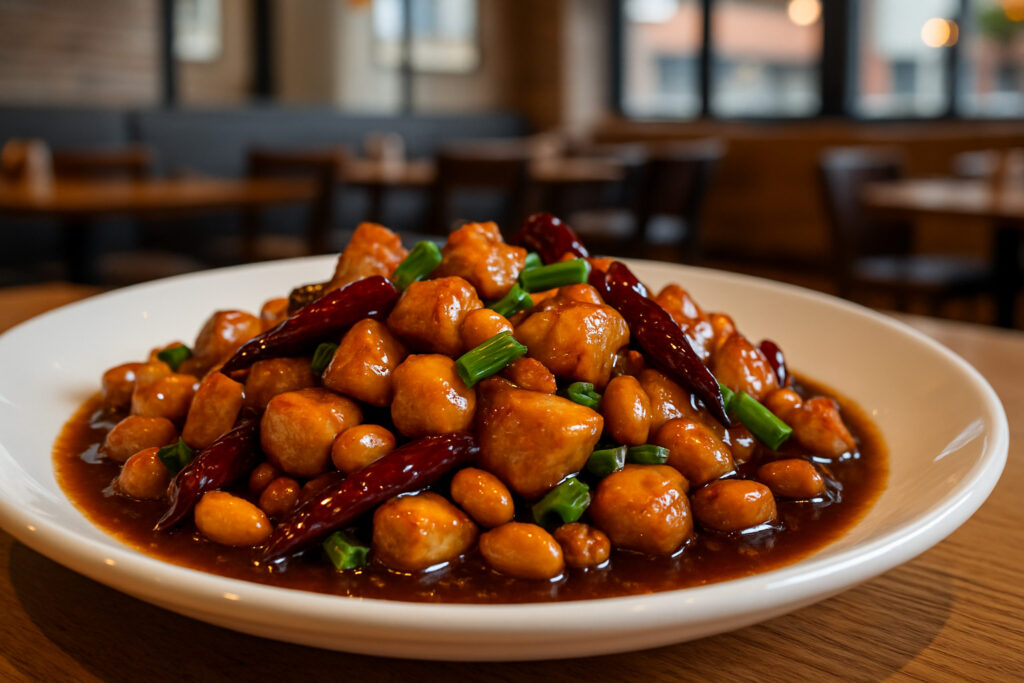Why Kung Pao Chicken Remains a Global Favorite
Kung pao chicken is a spicy stir-fried dish from China’s Sichuan province featuring diced chicken, peanuts, dried chilies, and Sichuan peppercorns in a sweet-savory sauce. This iconic dish delivers the perfect balance of flavors – sweet, sour, salty, and spicy – with a signature numbing heat that keeps people coming back for more.
Quick Kung Pao Chicken Facts:
- Origin: Sichuan Province, China (mid-to-late 19th century)
- Named after: Qing Dynasty official Ding Baozhen’s title “Gong Bao”
- Key ingredients: Chicken, peanuts, dried chilies, Sichuan peppercorns
- Flavor profile: Sweet, sour, salty, spicy with numbing heat
- Calories: 372-692 per serving depending on preparation
- Heat level: Moderately spicy (adjustable)
The authentic Sichuan version differs significantly from Western takeout adaptations. Traditional Kung Pao is a dry stir-fry with minimal sauce, while American versions often feature bell peppers, celery, and a glossier coating. Both have their place, but understanding these differences helps you appreciate why this dish has traveled so successfully across cultures.
Whether you’re seeking the fiery authenticity of a Sichuan kitchen or the milder comfort of takeout-style preparation, Kung Pao chicken offers something for every palate. The key lies in balancing the ma-la sensation – that distinctive numbing spiciness from Sichuan peppercorns paired with chili heat.

Kung pao chicken vocab explained:
History & Origins of Kung Pao Chicken
The tale begins with Ding Baozhen (1820-1886), a high-ranking official who served as governor of Sichuan Province during the mid-to-late 19th century. His official title was “Gong Bao” (宫保), meaning “Palace Guardian” – and here’s where it gets clever. The full Chinese name “Gong Bao Ji Ding” (宫保鸡丁) contains a delightful pun: the character “ding” (丁) refers both to the governor’s surname and the diced shape of the chicken cubes.
Ding Baozhen was a genuine food enthusiast who challenged his kitchen staff to create something extraordinary. The original Kung pao chicken emerged from a brilliant fusion of two regional specialties: Shandong’s “sauce-fried chicken” and Guizhou’s “pepper-fried chicken.” When Ding transferred from his Guizhou posting to Sichuan, his chefs adapted these techniques using local Sichuan ingredients – particularly those famous tongue-numbing peppercorns.
The dish’s journey wasn’t always smooth sailing. During China’s Cultural Revolution, officials viewed the imperial connection as politically problematic. They renamed it “spicy chicken” (辣子鸡丁) to scrub away any feudal associations. Fortunately, the 1980s brought rehabilitation, and Kung pao chicken reclaimed its rightful name and place in Chinese cuisine. Scientific research on Sichuan food culture shows how political changes affected traditional recipes during this period.
The Qing-Era Story Behind Kung Pao Chicken
The imperial title “Gong Bao” carried serious weight – Palace Guardians were trusted with protecting imperial interests across the empire. Yet Ding Baozhen’s culinary legacy has outlasted his administrative achievements by centuries. Historical accounts suggest this Kung pao chicken recipe began as a closely guarded family secret, served only in Ding’s private household before eventually making its way into Beijing’s prestigious court cuisine.
Timeline of a Global Icon
The change from a 19th-century governor’s private dinner to today’s global takeout staple reads like a culinary trip novel. The 1850s-1880s saw the original creation in Ding Baozhen’s household, while the late 1800s brought introduction to Beijing court cuisine. The 1960s-1970s marked the temporary renaming during the Cultural Revolution, followed by name rehabilitation in the 1980s.
The real explosion came during the 1990s-2000s as Chinese immigration accelerated, particularly to the United States. Chinese restaurant owners adapted the dish for local palates, often adding bell peppers and toning down the heat. By the present day, you’ll find some version of Kung pao chicken on virtually every Chinese takeout menu worldwide.
Key Ingredients & Flavor Science
What makes kung pao chicken so irresistible? It’s all about the perfect marriage of ingredients that create layers of flavor and texture. Each component plays a specific role in building that signature ma-la sensation – the numbing, spicy combination that defines authentic Sichuan cuisine.
The star of the show is chicken, but not just any cut will do. Dark meat from chicken thighs is the secret weapon here. While many home cooks reach for chicken breast, thighs stay juicier and more tender during the intense heat of wok cooking. Professional chefs use a technique called “velveting” – marinating the diced chicken in cornstarch, Shaoxing wine, and soy sauce to create an incredibly silky texture.
Peanuts aren’t just a garnish – they’re essential for both flavor and texture. Traditional recipes call for fresh, unroasted peanuts that get deep-fried right in the wok until golden. The key is adding them at the very last moment to preserve that satisfying crunch.
The aromatic trio of garlic, ginger, and scallions forms the flavor foundation. When these hit hot oil, they release essential oils that create the irresistible aroma wafting from every great kung pao chicken dish.
The Power Duo: Chilies & Peppercorns
Here’s where kung pao chicken gets its personality. Dried red chilies, particularly the “facing heaven” variety, provide heat without overwhelming the dish. These aren’t meant to be eaten – they’re fried whole to release their smoky oils.
But the real magic happens with Sichuan peppercorns. Despite their name, these aren’t related to black pepper at all. They’re the dried husks of the prickly ash tree, and when heated, they release compounds that literally numb your tongue. This creates the distinctive ma sensation that makes room for other flavors to shine through the heat.
Sauce Ratio & Kung Pao Chicken Chemistry
The sauce that brings everything together in kung pao chicken follows a time-tested formula. Traditional recipes use a 1:1:1 ratio of light soy sauce, Chinese black vinegar (Chinkiang), and sugar as the base, with a splash of dark soy sauce for color and depth.
Light soy sauce provides the primary saltiness and umami punch, while dark soy sauce adds that rich, molasses-like depth and beautiful color. Chinese black vinegar contributes the essential sour note – it’s similar to balsamic vinegar but with a more pronounced savory edge.
Sugar does more than just add sweetness – it balances the heat and acidity while helping the sauce caramelize slightly during high-heat cooking. Cornstarch mixed with water creates that glossy coating that clings to ingredients without becoming gloppy.
Shaoxing wine, a fermented rice wine, adds complexity and helps tenderize the chicken. If you can’t find it, dry sherry works as a substitute. For more traditional Chinese cooking techniques, check out our Cookbook: Kung Pao Chicken resource.
Nutritional Snapshot & Health Considerations
A typical serving of kung pao chicken packs 372-692 calories, depending on how it’s prepared and portion size. The protein content is impressive – usually 27-31 grams per serving, making it a substantial main course. However, sodium levels can be high (1,302-1,639mg per serving) due to soy sauce and other seasonings.
For health-conscious diners, kung pao chicken offers some real benefits. It’s naturally gluten-free when made with tamari instead of soy sauce, provides healthy fats from peanuts, and includes vitamin C from chilies. The dish is also relatively low in carbohydrates (11-20g per serving) compared to other Chinese takeout options.

Authentic vs. Western Variations
The change of kung pao chicken from Sichuan province to global takeout menus tells a fascinating story of culinary adaptation. What started as a fiery, dry-fried dish in Chinese kitchens became something entirely different when it crossed oceans and borders.
Understanding these variations isn’t about declaring one version “better” than another – it’s about appreciating how food evolves to meet different tastes and expectations. The authentic Sichuan version delivers an intense, numbing heat that challenges your palate, while American takeout versions offer comfort and familiarity.
| Aspect | Sichuan Authentic | American Takeout | Guizhou Version |
|---|---|---|---|
| Sauce | Minimal, dry stir-fry | Glossy, abundant | Fermented chili paste |
| Vegetables | Scallion whites only | Bell peppers, celery | Larger vegetables |
| Heat Level | Very spicy | Mild to moderate | Extremely spicy |
| Chicken Cut | Small uniform cubes | Larger chunks | Skin-on cubes |
| Peanuts | Fresh, wok-fried | Pre-roasted | Often substituted |
| Texture | Dry, flavored | Saucy, milder | Rich, paste-coated |
The differences go beyond just spice levels. Traditional kung pao chicken uses precise knife work to create uniform chicken cubes that cook evenly and absorb flavors perfectly. Western versions often feature larger, irregular pieces that are easier to prepare in high-volume restaurant kitchens.
Sichuan Restaurant Kung Pao Chicken
Walking into an authentic Sichuan restaurant and ordering kung pao chicken can be a revelation if you’re used to takeout versions. The dish arrives looking almost dry compared to its saucy American cousin, with just enough coating to make the ingredients glisten under the restaurant lights.
The heat builds gradually but persistently. First comes the chili burn, then the distinctive numbing sensation from Sichuan peppercorns that makes your tongue tingle. This ma-la combination isn’t just about being spicy – it’s about creating layers of sensation that keep you reaching for more.
Traditional preparation relies on “facing heaven” chilies – small, potent peppers that point upward on the plant. These aren’t meant to be eaten whole but rather to infuse the oil with their smoky heat. The chicken pieces are cut into precise small cubes, ensuring every bite delivers maximum flavor impact.
Fresh peanuts get fried directly in the wok until golden, developing a subtle smokiness that pre-roasted nuts simply can’t match. The entire dish comes together in minutes of high-heat cooking, preserving the individual character of each ingredient while creating a harmonious whole.
Takeout-Style Kung Pao Chicken
American Chinese restaurants didn’t accidentally create a milder version of kung pao chicken – they deliberately adapted it for local tastes. The result is a dish that shares a name with the original but offers an entirely different eating experience.
The sauce becomes the star here, glossy and abundant enough to coat every piece of chicken and vegetable. Bell peppers and celery add crunch and color while dramatically reducing the heat level. Many versions include more vegetables than chicken, creating a more balanced dish for diners who want their protein mixed with plenty of veggies.
Cashews sometimes replace peanuts, offering a buttery richness that complements the sweeter sauce profile. The chicken pieces are often larger and more irregularly cut, making them easier to eat with a fork – a practical consideration for American dining habits.
This version excels as comfort food. It’s approachable for spice-sensitive diners and pairs beautifully with steamed rice for a satisfying weeknight dinner. While it may not challenge your palate like the authentic version, it has earned its place in the hearts of countless takeout lovers.
Creative Twists & Dietary Adaptations
Modern chefs have acceptd kung pao chicken as a template for creativity. Kung pao shrimp brings sweetness and tender texture, while kung pao tofu offers a vegetarian option that soaks up the sauce beautifully. Some adventurous restaurants even serve kung pao frog legs, staying closer to traditional Chinese protein preferences.
Dietary restrictions don’t have to mean missing out. Gluten-free kung pao chicken substitutes tamari for soy sauce and carefully checks all other ingredients for hidden gluten. The dish naturally accommodates this swap without losing its essential character.
Vegan versions use firm tofu or king oyster mushrooms as protein sources. While they obviously lack the chicken’s texture, they create satisfying meals that honor the original’s flavor balance. Some creative cooks use cauliflower florets for added texture variety.
Health-conscious adaptations reduce sodium by cutting back on soy sauce and increasing fresh aromatics like ginger and garlic. Others serve the dish over cauliflower rice instead of traditional jasmine rice, creating a lower-carb meal that still delivers on satisfaction.
Step-by-Step Guide: Cooking Restaurant-Quality Kung Pao Chicken
Making restaurant-quality Kung pao chicken at home is absolutely achievable once you understand the rhythm of proper stir-frying. The secret lies in mise en place – that French culinary term meaning “everything in its place.” You’ll want every ingredient prepped and ready before you fire up that wok, because authentic stir-frying happens lightning-fast.

The difference between soggy takeout and restaurant-quality Kung pao chicken comes down to heat control and timing. Professional kitchens achieve that distinctive smoky flavor called wok hei through blazing-hot cooking surfaces and precise technique. While your home stove might not reach commercial BTU levels, following the right sequence will get you remarkably close.
For more inspiration on perfecting your Chinese cooking techniques, explore our collection of chicken recipes.
Prep & Marinate for Tender Bites
Start with boneless chicken thighs cut into small, uniform cubes – about half an inch works perfectly. Dark meat stays juicier than breast meat during high-heat cooking, and the uniform size ensures everything cooks evenly.
The marinade is where the magic begins. Combine your chicken cubes with cornstarch, Shaoxing wine, light soy sauce, a touch of sesame oil, and white pepper. Massage this mixture gently with your hands – the chicken should feel slightly sticky from the cornstarch coating. Let it marinate for 20 minutes at room temperature, or up to 4 hours in the refrigerator if you’re planning ahead.
This velveting technique creates an invisible protective shield around each piece of chicken. The cornstarch forms a barrier that locks in moisture while the wine and soy sauce penetrate deep into the meat.
While the chicken marinates, whisk together your sauce ingredients: light soy sauce, dark soy sauce, Chinese black vinegar, sugar, and cornstarch with a splash of water. Make sure there are no lumps – a smooth sauce is crucial for even coating.
Stir-Fry Technique for Kung Pao Chicken Perfection
Heat your wok or largest skillet until it’s smoking hot – literally smoking. This might seem scary, but it’s essential for developing proper flavor. Add oil and immediately toss in your dried chilies and Sichuan peppercorns. They should sizzle and become fragrant within 30 seconds.
Add the marinated chicken in a single layer, resisting the urge to stir immediately. Let it sear undisturbed for 2-3 minutes to develop that golden color and concentrated flavor. Then stir-fry until just cooked through.
Push the chicken to one side of your wok and add garlic, ginger, and scallion whites to the empty space. Let them sizzle for 30 seconds until fragrant, then mix everything together. This technique prevents the aromatics from burning while ensuring they release maximum flavor.
Give your sauce a quick stir (cornstarch settles quickly), then pour it into the wok. Toss everything together rapidly until the sauce thickens and coats the chicken beautifully. The whole process should take 1-2 minutes.
Adjusting Heat, Swapping Ingredients & Going Gluten-Free
To tone down the heat in your Kung pao chicken, remove the seeds from dried chilies before cooking, or simply use fewer chilies. For those who prefer mild flavors, substitute sweet red peppers for some of the hot chilies.
Going gluten-free is surprisingly simple. Replace regular soy sauce with tamari and double-check that any hoisin sauce you use is certified gluten-free. The cooking technique stays identical.
Protein swaps work beautifully with this technique. Firm tofu, shrimp, or even beef can substitute for chicken using the same marinade and cooking method. If you’re exploring more Chinese flavors, check out our guide to Chinese food near me for inspiration.
Kung Pao Chicken Sauce Ratio & Finishing Touch
The classic sauce ratio for two generous servings uses 2 tablespoons light soy sauce, 1 tablespoon dark soy sauce, 1 tablespoon Chinese black vinegar, 1 teaspoon sugar, and 1 teaspoon cornstarch mixed with 2 tablespoons water. This creates just enough sauce to coat without drowning the ingredients.
Taste and adjust fearlessly. Too sour? Add more sugar. Too sweet? Splash in more vinegar. The sauce should balance sweet, sour, salty, and umami flavors while letting those beautiful ma-la spices sing through.
The final crucial step: add roasted peanuts and scallion greens in the last 30 seconds of cooking. This preserves the peanuts’ satisfying crunch and the scallions’ fresh bite, creating textural contrast that makes each bite interesting.
Serving, Pairing & Storage Tips
The magic of kung pao chicken happens when it hits the table piping hot, straight from the wok. Steamed jasmine rice is the classic companion – its fluffy, neutral flavor provides the perfect canvas for those bold, complex flavors while helping tame the heat for anyone who might be feeling the burn.

Building a complete meal around kung pao chicken is all about balance. You want sides that complement rather than compete with those intense flavors. Think cooling cucumber salad to refresh your palate, or a simple hot and sour soup to warm up your taste buds.
Side Dishes That Shine Next to Kung Pao Chicken
Scallion pancakes make an absolutely brilliant pairing – their crispy exterior and chewy interior create textural contrast that plays beautifully against the tender chicken and crunchy peanuts. The mild onion flavor adds depth without overwhelming your already-busy palate.
For something refreshing, smashed cucumber salad is your best friend. The cool, crisp vegetables and tangy dressing work like a palate cleanser between bites of spicy chicken.
Hot and sour soup serves as an excellent starter, gently warming up your taste buds for the main event. The tangy broth and silky tofu create a nice bridge into the more intense flavors ahead.
If you’re looking for lighter options, steamed bok choy or Chinese broccoli add nutritional value while keeping the meal culturally authentic. For carb alternatives, cauliflower rice works surprisingly well, though it won’t soak up the sauce quite like traditional jasmine rice.
Want to make it a feast? Consider adding dumplings to create a more substantial meal. Their mild filling and starchy wrapper provide a perfect counterbalance to the intense kung pao chicken flavors.
Storing & Reheating Without Losing Crunch
Proper storage can keep your kung pao chicken delicious for up to three days in the refrigerator. Glass containers work best – they won’t absorb those strong flavors and odors like plastic can. Store the peanuts separately if you can manage it – they’ll stay much crunchier when you add them back during reheating.
When it’s time to reheat, skip the microwave if possible. A hot wok or skillet with a splash of oil brings the dish back to life much better. Quickly stir-fry those leftovers until heated through – this method helps restore some of the original texture and prevents the sauce from turning gummy.
Lost that satisfying peanut crunch? Just toast some fresh peanuts in a dry pan for 2-3 minutes and stir them in during the last minute of reheating. This simple trick restores the textural contrast that makes the dish so special.
For meal prep enthusiasts, kung pao chicken works wonderfully in grain bowls. Prepare all your components separately and combine them when you’re ready to eat, adding fresh peanuts and scallion greens for optimal texture and flavor.
Frequently Asked Questions about Kung Pao Chicken
How spicy is authentic kung pao chicken, and how can I tone it down?
Authentic Sichuan kung pao chicken brings serious heat – we’re talking about a dish that can make your tongue tingle and your forehead sweat. The spice comes from two different sources working together: dried chilies deliver that familiar burning sensation, while Sichuan peppercorns create a unique numbing feeling.
If you’re not ready for that level of intensity, you can absolutely tone it down without losing the dish’s character. The easiest trick is removing the seeds from dried chilies before cooking, since that’s where most of the capsaicin lives. You can also simply use fewer chilies or swap them for milder varieties like Kashmiri red chilies.
For the numbing sensation from Sichuan peppercorns, start with just a pinch instead of the full amount. Adding extra vegetables like bell peppers also helps distribute the heat throughout the dish, making each bite more manageable.
Can kung pao chicken be made completely gluten-free?
Absolutely! Kung pao chicken is actually one of the easier Chinese dishes to make gluten-free with just a few simple swaps. The main culprit is soy sauce, which traditionally contains wheat. Replace it with tamari (which is basically gluten-free soy sauce) or coconut aminos if you want a slightly sweeter flavor.
Most other ingredients are naturally gluten-free already. The cornstarch used for coating the chicken and thickening the sauce? Totally fine. The chicken, peanuts, chilies, Sichuan peppercorns, vinegar, garlic, and ginger? All naturally gluten-free.
Just watch out for any pre-made sauces if you’re taking shortcuts – some hoisin sauces contain wheat, so look for certified gluten-free versions.
What’s the best substitute if I can’t find Sichuan peppercorns?
Here’s the honest truth: nothing will give you exactly the same experience as Sichuan peppercorns. That distinctive numbing sensation is pretty unique in the spice world. But if you’re stuck without them, there are some interesting alternatives.
White pepper is probably your best bet – it provides heat without the numbing quality, and it’s commonly used in Chinese cooking. Black pepper works too, though it gives a different kind of spiciness that’s more familiar to Western palates. Some adventurous cooks try pink peppercorns, which offer a floral note and just a hint of that numbing sensation, though much milder.
Honestly though, we’d recommend ordering Sichuan peppercorns online – they’re widely available, not too expensive, and they keep well in the freezer. Once you taste the real deal, you’ll understand why they’re worth seeking out for authentic Sichuan flavors.
Conclusion
Kung pao chicken represents more than just a popular takeout dish – it’s a culinary bridge connecting authentic Sichuan tradition with global adaptation. From its origins in Qing Dynasty governor Ding Baozhen’s kitchen to its current worldwide popularity, this remarkable dish shows how great recipes can travel across cultures while keeping their essential soul intact.
At The Dining Destination, we believe that understanding a dish’s story and technique makes every single bite more meaningful. Whether you’re drawn to the fiery authenticity of traditional Sichuan preparation or the approachable comfort of takeout-style adaptation, Kung pao chicken offers endless possibilities for culinary exploration right in your own kitchen.
The real magic lies in that perfect balance – sweet, sour, salty, and spicy flavors dancing together with the unique ma-la sensation that defines exceptional Sichuan cooking. Once you master the basic technique and understand how each ingredient plays its part, you’ll create restaurant-quality results that honor both tradition and your personal taste preferences.
We encourage you to roll up your sleeves and try making authentic Kung pao chicken at home using the techniques we’ve shared. Start with quality ingredients, respect the cooking process, and don’t be afraid to adjust those heat levels to match your spice tolerance.
Ready to explore more culinary trips? Check out our comprehensive resource guides covering global cuisines and cooking methods that bring restaurant-quality results straight to your home kitchen. Your next favorite dish is just waiting to be finded.








1 thought on “An Essential Guide to Kung Pao Chicken: Origins, Ingredients & More”
Pingback: 7 Little Known Facts About Ryan Trahan - The Dining Destination
Comments are closed.